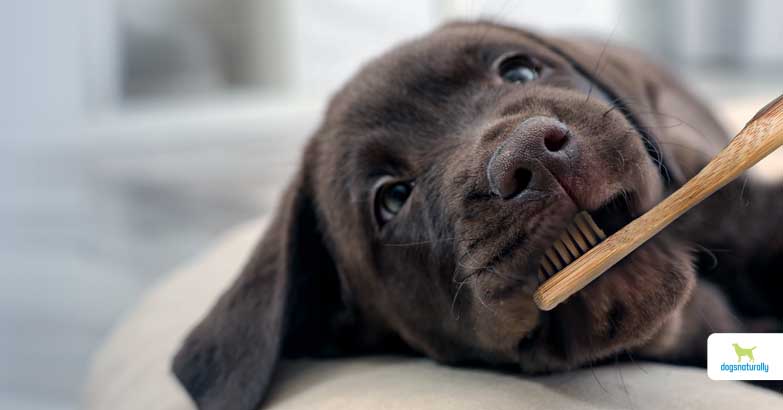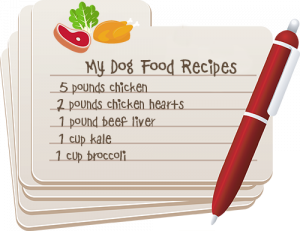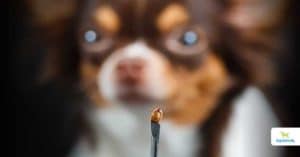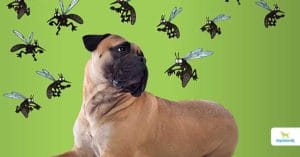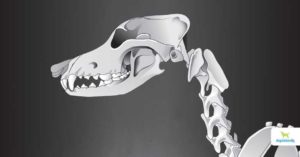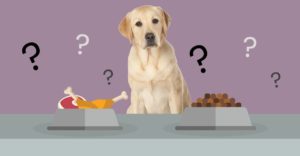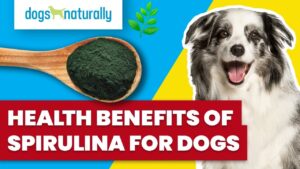Your dog’s oral health is a window into his overall health. From puppyhood through to his senior years, you should be practicing good dental health. That includes a healthy whole food diet, some raw meaty bones for chewing and regular teeth brushing.
So here are some tips on how to brush your dog’s teeth …
Do I Really Need To Brush My Dog’s Teeth?
Yes, it’s always a good idea to brush your dog’s teeth regularly. Even if he’s on a raw diet and gets plenty of bones, some dogs’ teeth still need brushing to keep them healthy … especially as they get older. If your dog has smelly breath or his teeth start to get discolored, you definitely need to brush regularly.
Bad breath is a sign of bacteria that can lead to dental problems like gingivitis and periodontal disease. But more importantly, it can lead to systemic disease throughout your dog’s body. Kidney, liver and heart disease are often rooted in chronic inflammation and bacteria that stem from poor dental health.
Brushing your dog’s teeth will maintain his overall health. When you brush your dog’s teeth you’ll be reducing plaque buildup, minimizing bacteria … and keeping his breath fresh. All of this helps prevent gum disease. This is especially important for small breeds who are even more prone to dental disease.
RELATED: Dog Teeth Cleaning: A Simple Guide
How To Get Your Dog Used To Brushing Teeth
It’s not always easy to get your dog used to you brushing his teeth. So most people ask how to brush dog teeth when they refuse.
What you’ll need to do is use baby steps to slowly get your dog used to it. Keep the mood light and comforting. Talk to your dog and reward him with lots of praise, pets and cuddles.
Here are some tips on how to brush your dog’s teeth as you gain his trust and build his comfort with the activity.
Start Early With A Puppy
If you start in puppyhood, playing with him and putting your fingers in his mouth is part of his training. So here’s how to brush a puppy’s teeth for the first time.
You can create a teeth-cleaning game so he’ll look forward to it. Dip your fingers in broth or MCT oil so they’ll be tasty. Massage your fingers all over your dog’s teeth. You don’t need to pry open his jaws. When he keeps his teeth closed, you can push his lips up and reach his teeth and gums more easily. Reach into the back for the molars too. Do this consistently for a few minutes every night.
You can do the same thing with an older dog but it may take longer for him to accept having your fingers in his mouth. It may be a slow process but you’ll be bonding with him and building his overall health.
Use Dog Toothpaste
If you’re wondering “can i brush my dog’s teeth with toothpaste?” … the answer is, only use toothpaste made for dogs. Don’t ever use human toothpaste as it has dangerous ingredients like xylitol that can be deadly for dogs.
Here’s what to brush your dog’s teeth with at home. Find a natural, dog-friendly toothpaste or powder that’s free from chemicals, dyes, preservatives and artificial additives. Choose one with organic ingredients … or you can make your own.
Each time you work on training, dip your finger into the toothpaste and let your dog taste it, gradually progressing to rubbing it on his teeth and gums.
What Can I Use To Brush My Dog’s Teeth?
You can choose a toothbrush made for dogs … or you can use a human toothbrush. Some dog toothbrushes have specially angled heads that may be easier to use. Ideally use a natural brush like a bamboo brush with soft bristles. You can also use a finger brush or even a piece of gauze wrapped around your finger.
Once your dog is used to you putting your fingers in his mouth and rubbing his teeth and gums, you introduce the brush in the same way. Add a bit of broth or MCT oil or doggy toothpaste. No brushing is needed at this point.
You can use MCT oil as you did when you were practicing. Or you can use a probiotic powder that will help get beneficial bacteria into your dog’s mouth … and fight bad bacteria that lead to tooth and gum disease.
If your dog resists tooth brushing, you can also buy prebiotic powder to add to your dog’s water bowl. Over time this can help resolve oral issues – maybe even with minimal brushing!
Find The Right Time And Place
You don’t want to feel pressured or hurried so find a time when it’s just you and your dog. Try kneeling or sitting in front or to your dog’s side, or hold a smaller dog in your lap. You might even want to use a towel or blanket to wrap your dog … not as confinement but as a sense of security. Introduce that along with the other steps.
Start Slowly
Now you’re ready to put it all together. In a comfortable spot, you’ve got your dog, toothbrush and toothpaste. As you use the brush, angle the bristles to reach the gum line. Place them at a 45-degree angle against their teeth so the bristles massage the gum line and reach any plaque. You only want to spend 2-3 minutes doing a few teeth at a time as you get into full brushing. Do a few minutes each day.
Use small circles and brush to the top and bottom of each tooth. There might be slight bleeding if your dog has beginning gum disease. Heavier bleeding can mean 2 things: you‘re brushing too hard or he has gum disease. If doesn’t improve, you’ll need to see your veterinary dental specialist.
Focus On Plaque
Work on the outside of your dog’s canine and back teeth where plaque tends to collect. You don’t need to brush the inside of the teeth … your dog’s coarse tongue will help keep the insides clean.
How Often Should You Brush Your Dog’s Teeth?
Your dog’s teeth should be brushed daily, just like yours. It’s a good habit to get into and prevents any surprises over time. When you brush your dog’s teeth regularly, you’ll be familiar with his mouth and teeth, so you’ll notice loose teeth, tartar buildup or bad breath … all signs you might need to see a veterinary dental specialist for a checkup.
Keep brushing sessions short to avoid you both getting stressed. And end on a high note. Each time you’ve finished, reward your dog with a treat or play time … something to make it a positive experience.
What Else Can I Do To Keep My Dog’s Teeth Healthy?
As part of your dog’s ongoing dental health, you can also do the following things.
- Brush your dog’s teeth with pre- and probiotics to fight bad bacteria from plaque that can lead to gum disease or periodontal disease.
- Give your dog recreational bones or dental chew toys to scrape the plaque off his teeth.
- Feed raw meat, organs and bones. When your dog chews, gnaws and tears meat and meaty bones it will loosen plaque on his teeth.
RELATED: 5 ways to strengthen your dog’s teeth …
Brushing your dog’s teeth is good for his overall health … and it’s also a good bonding experience for you and your dog.

